NRSG370 Case Study: Mr. Peter Ling's Surgical Nursing Care Analysis
VerifiedAdded on 2022/09/28
|10
|2698
|23
Case Study
AI Summary
This case study focuses on the nursing care of Mr. Peter Ling, a 67-year-old male who underwent open mesh inguinal hernia repair and presented with post-operative complications including elevated vital signs, pain, and a green purulent discharge from the incision site. The assignment utilizes the clinical reasoning cycle to assess Mr. Ling's situation, collect and process relevant health information, identify nursing problems (impaired circulation, acute pain, and risk of infection), establish SMART goals, plan and implement nursing interventions such as monitoring vital signs, pain management, and wound care, and evaluate the effectiveness of the interventions. The case study also addresses Mr. Ling's pre-existing conditions of hypertension, hyperlipidemia, and mild congestive heart failure, which influenced his recovery. The analysis highlights the importance of evidence-based practice and holistic care in managing patients with both medical and surgical needs, emphasizing the cyclical nature of clinical reasoning for improved patient outcomes. The study concludes with reflections on the learning experience and the challenges encountered in providing care to a patient with multiple health issues.
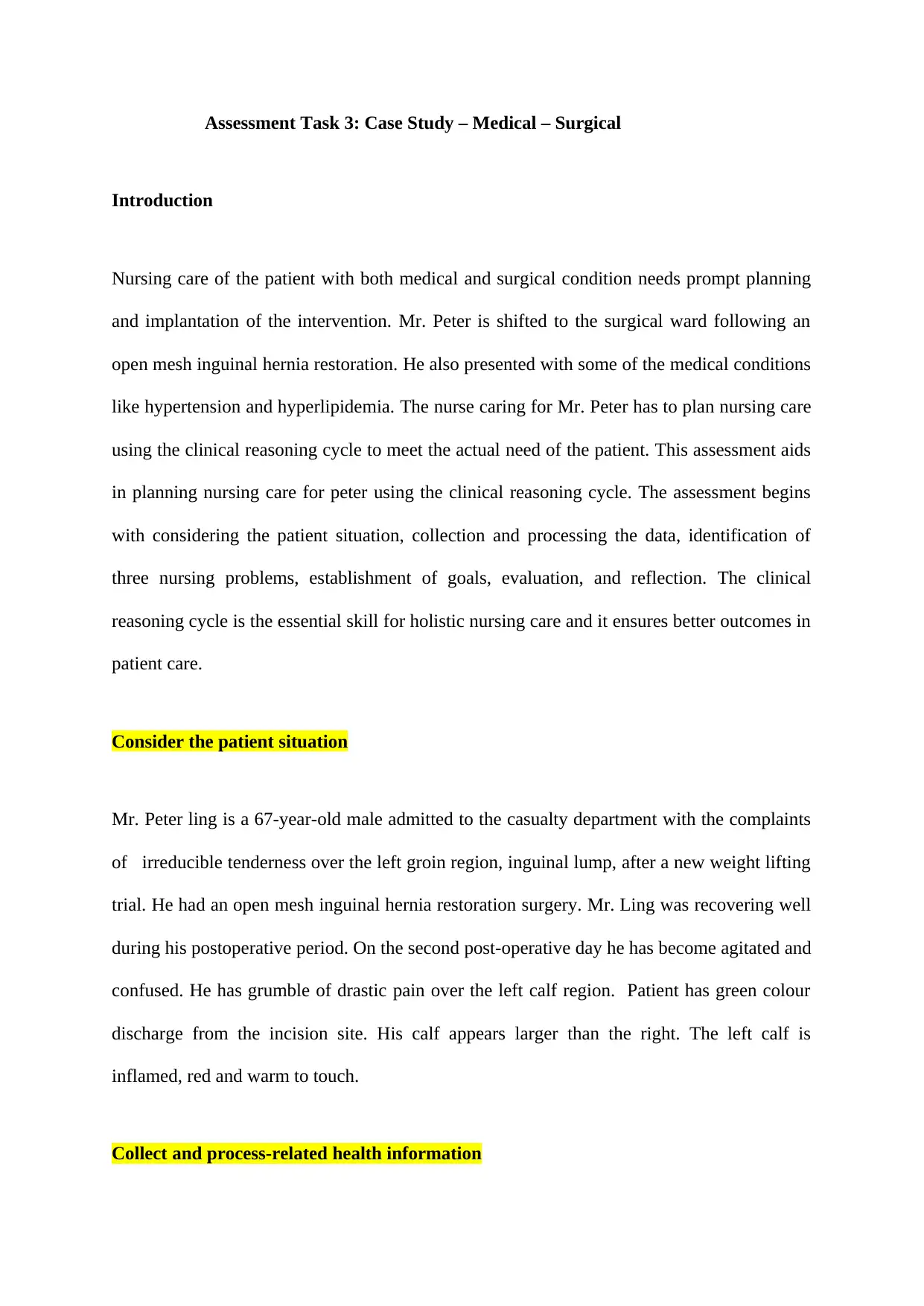
Assessment Task 3: Case Study – Medical – Surgical
Introduction
Nursing care of the patient with both medical and surgical condition needs prompt planning
and implantation of the intervention. Mr. Peter is shifted to the surgical ward following an
open mesh inguinal hernia restoration. He also presented with some of the medical conditions
like hypertension and hyperlipidemia. The nurse caring for Mr. Peter has to plan nursing care
using the clinical reasoning cycle to meet the actual need of the patient. This assessment aids
in planning nursing care for peter using the clinical reasoning cycle. The assessment begins
with considering the patient situation, collection and processing the data, identification of
three nursing problems, establishment of goals, evaluation, and reflection. The clinical
reasoning cycle is the essential skill for holistic nursing care and it ensures better outcomes in
patient care.
Consider the patient situation
Mr. Peter ling is a 67-year-old male admitted to the casualty department with the complaints
of irreducible tenderness over the left groin region, inguinal lump, after a new weight lifting
trial. He had an open mesh inguinal hernia restoration surgery. Mr. Ling was recovering well
during his postoperative period. On the second post-operative day he has become agitated and
confused. He has grumble of drastic pain over the left calf region. Patient has green colour
discharge from the incision site. His calf appears larger than the right. The left calf is
inflamed, red and warm to touch.
Collect and process-related health information
Introduction
Nursing care of the patient with both medical and surgical condition needs prompt planning
and implantation of the intervention. Mr. Peter is shifted to the surgical ward following an
open mesh inguinal hernia restoration. He also presented with some of the medical conditions
like hypertension and hyperlipidemia. The nurse caring for Mr. Peter has to plan nursing care
using the clinical reasoning cycle to meet the actual need of the patient. This assessment aids
in planning nursing care for peter using the clinical reasoning cycle. The assessment begins
with considering the patient situation, collection and processing the data, identification of
three nursing problems, establishment of goals, evaluation, and reflection. The clinical
reasoning cycle is the essential skill for holistic nursing care and it ensures better outcomes in
patient care.
Consider the patient situation
Mr. Peter ling is a 67-year-old male admitted to the casualty department with the complaints
of irreducible tenderness over the left groin region, inguinal lump, after a new weight lifting
trial. He had an open mesh inguinal hernia restoration surgery. Mr. Ling was recovering well
during his postoperative period. On the second post-operative day he has become agitated and
confused. He has grumble of drastic pain over the left calf region. Patient has green colour
discharge from the incision site. His calf appears larger than the right. The left calf is
inflamed, red and warm to touch.
Collect and process-related health information
Paraphrase This Document
Need a fresh take? Get an instant paraphrase of this document with our AI Paraphraser
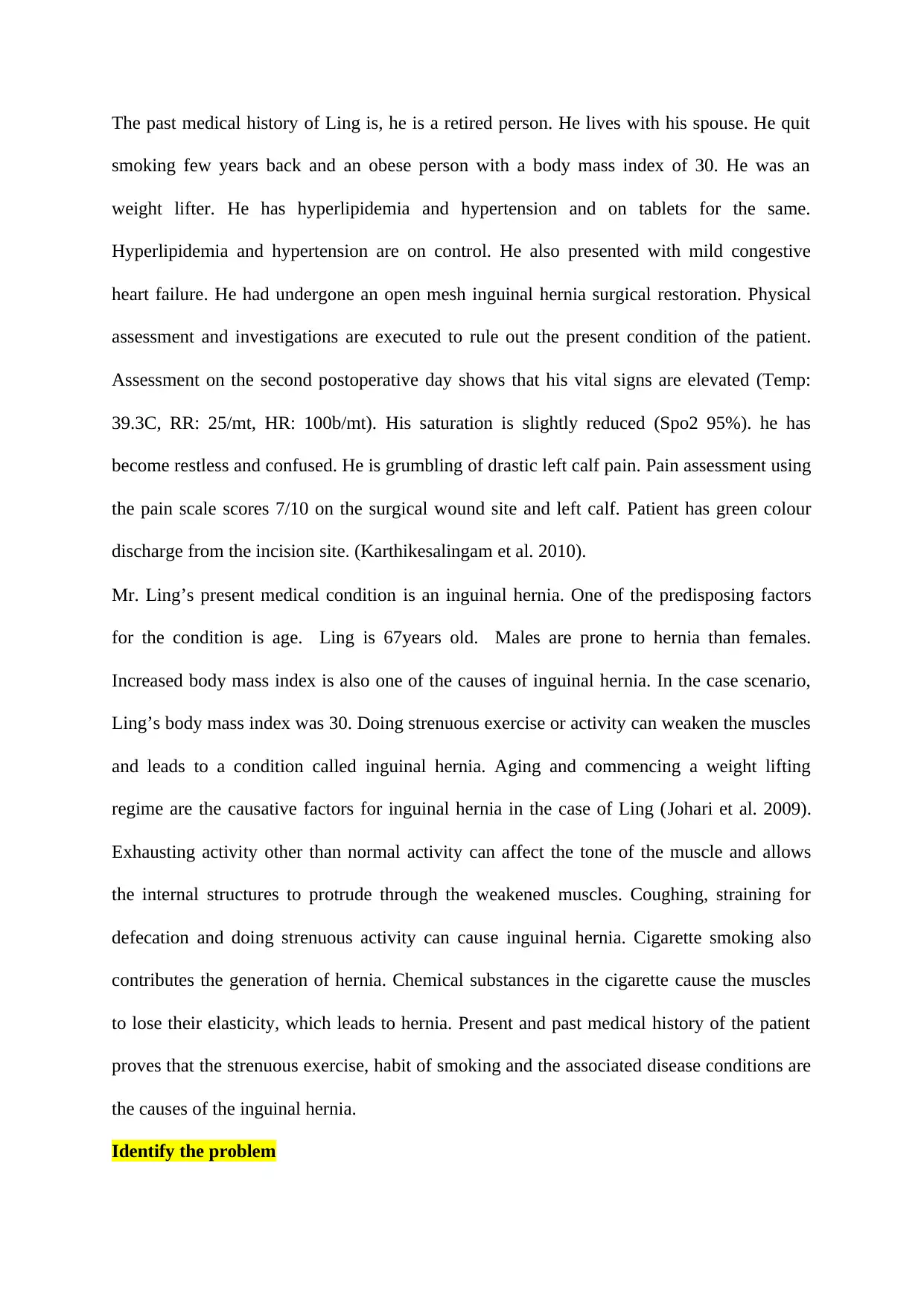
The past medical history of Ling is, he is a retired person. He lives with his spouse. He quit
smoking few years back and an obese person with a body mass index of 30. He was an
weight lifter. He has hyperlipidemia and hypertension and on tablets for the same.
Hyperlipidemia and hypertension are on control. He also presented with mild congestive
heart failure. He had undergone an open mesh inguinal hernia surgical restoration. Physical
assessment and investigations are executed to rule out the present condition of the patient.
Assessment on the second postoperative day shows that his vital signs are elevated (Temp:
39.3C, RR: 25/mt, HR: 100b/mt). His saturation is slightly reduced (Spo2 95%). he has
become restless and confused. He is grumbling of drastic left calf pain. Pain assessment using
the pain scale scores 7/10 on the surgical wound site and left calf. Patient has green colour
discharge from the incision site. (Karthikesalingam et al. 2010).
Mr. Ling’s present medical condition is an inguinal hernia. One of the predisposing factors
for the condition is age. Ling is 67years old. Males are prone to hernia than females.
Increased body mass index is also one of the causes of inguinal hernia. In the case scenario,
Ling’s body mass index was 30. Doing strenuous exercise or activity can weaken the muscles
and leads to a condition called inguinal hernia. Aging and commencing a weight lifting
regime are the causative factors for inguinal hernia in the case of Ling (Johari et al. 2009).
Exhausting activity other than normal activity can affect the tone of the muscle and allows
the internal structures to protrude through the weakened muscles. Coughing, straining for
defecation and doing strenuous activity can cause inguinal hernia. Cigarette smoking also
contributes the generation of hernia. Chemical substances in the cigarette cause the muscles
to lose their elasticity, which leads to hernia. Present and past medical history of the patient
proves that the strenuous exercise, habit of smoking and the associated disease conditions are
the causes of the inguinal hernia.
Identify the problem
smoking few years back and an obese person with a body mass index of 30. He was an
weight lifter. He has hyperlipidemia and hypertension and on tablets for the same.
Hyperlipidemia and hypertension are on control. He also presented with mild congestive
heart failure. He had undergone an open mesh inguinal hernia surgical restoration. Physical
assessment and investigations are executed to rule out the present condition of the patient.
Assessment on the second postoperative day shows that his vital signs are elevated (Temp:
39.3C, RR: 25/mt, HR: 100b/mt). His saturation is slightly reduced (Spo2 95%). he has
become restless and confused. He is grumbling of drastic left calf pain. Pain assessment using
the pain scale scores 7/10 on the surgical wound site and left calf. Patient has green colour
discharge from the incision site. (Karthikesalingam et al. 2010).
Mr. Ling’s present medical condition is an inguinal hernia. One of the predisposing factors
for the condition is age. Ling is 67years old. Males are prone to hernia than females.
Increased body mass index is also one of the causes of inguinal hernia. In the case scenario,
Ling’s body mass index was 30. Doing strenuous exercise or activity can weaken the muscles
and leads to a condition called inguinal hernia. Aging and commencing a weight lifting
regime are the causative factors for inguinal hernia in the case of Ling (Johari et al. 2009).
Exhausting activity other than normal activity can affect the tone of the muscle and allows
the internal structures to protrude through the weakened muscles. Coughing, straining for
defecation and doing strenuous activity can cause inguinal hernia. Cigarette smoking also
contributes the generation of hernia. Chemical substances in the cigarette cause the muscles
to lose their elasticity, which leads to hernia. Present and past medical history of the patient
proves that the strenuous exercise, habit of smoking and the associated disease conditions are
the causes of the inguinal hernia.
Identify the problem
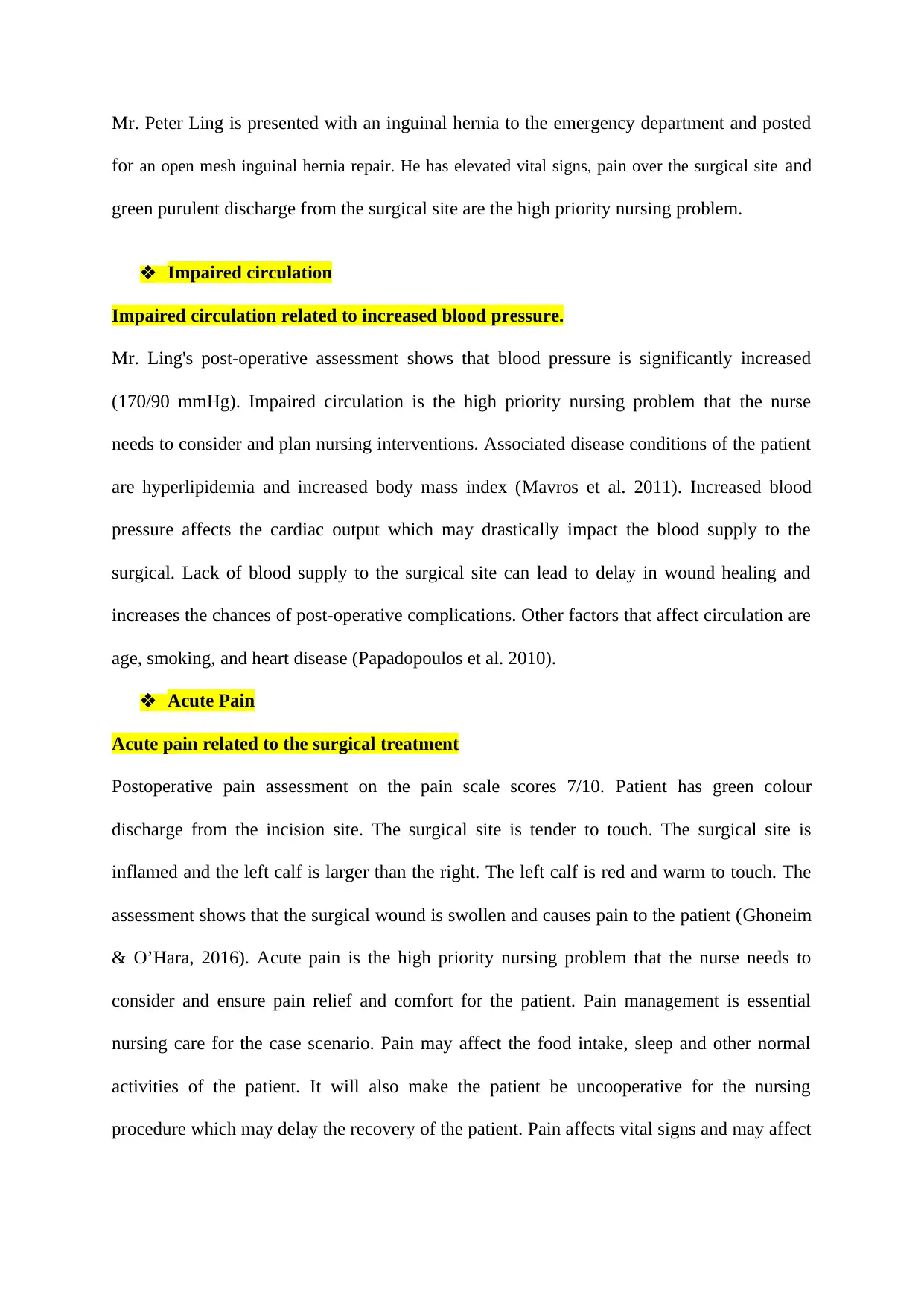
Mr. Peter Ling is presented with an inguinal hernia to the emergency department and posted
for an open mesh inguinal hernia repair. He has elevated vital signs, pain over the surgical site and
green purulent discharge from the surgical site are the high priority nursing problem.
Impaired circulation
Impaired circulation related to increased blood pressure.
Mr. Ling's post-operative assessment shows that blood pressure is significantly increased
(170/90 mmHg). Impaired circulation is the high priority nursing problem that the nurse
needs to consider and plan nursing interventions. Associated disease conditions of the patient
are hyperlipidemia and increased body mass index (Mavros et al. 2011). Increased blood
pressure affects the cardiac output which may drastically impact the blood supply to the
surgical. Lack of blood supply to the surgical site can lead to delay in wound healing and
increases the chances of post-operative complications. Other factors that affect circulation are
age, smoking, and heart disease (Papadopoulos et al. 2010).
Acute Pain
Acute pain related to the surgical treatment
Postoperative pain assessment on the pain scale scores 7/10. Patient has green colour
discharge from the incision site. The surgical site is tender to touch. The surgical site is
inflamed and the left calf is larger than the right. The left calf is red and warm to touch. The
assessment shows that the surgical wound is swollen and causes pain to the patient (Ghoneim
& O’Hara, 2016). Acute pain is the high priority nursing problem that the nurse needs to
consider and ensure pain relief and comfort for the patient. Pain management is essential
nursing care for the case scenario. Pain may affect the food intake, sleep and other normal
activities of the patient. It will also make the patient be uncooperative for the nursing
procedure which may delay the recovery of the patient. Pain affects vital signs and may affect
for an open mesh inguinal hernia repair. He has elevated vital signs, pain over the surgical site and
green purulent discharge from the surgical site are the high priority nursing problem.
Impaired circulation
Impaired circulation related to increased blood pressure.
Mr. Ling's post-operative assessment shows that blood pressure is significantly increased
(170/90 mmHg). Impaired circulation is the high priority nursing problem that the nurse
needs to consider and plan nursing interventions. Associated disease conditions of the patient
are hyperlipidemia and increased body mass index (Mavros et al. 2011). Increased blood
pressure affects the cardiac output which may drastically impact the blood supply to the
surgical. Lack of blood supply to the surgical site can lead to delay in wound healing and
increases the chances of post-operative complications. Other factors that affect circulation are
age, smoking, and heart disease (Papadopoulos et al. 2010).
Acute Pain
Acute pain related to the surgical treatment
Postoperative pain assessment on the pain scale scores 7/10. Patient has green colour
discharge from the incision site. The surgical site is tender to touch. The surgical site is
inflamed and the left calf is larger than the right. The left calf is red and warm to touch. The
assessment shows that the surgical wound is swollen and causes pain to the patient (Ghoneim
& O’Hara, 2016). Acute pain is the high priority nursing problem that the nurse needs to
consider and ensure pain relief and comfort for the patient. Pain management is essential
nursing care for the case scenario. Pain may affect the food intake, sleep and other normal
activities of the patient. It will also make the patient be uncooperative for the nursing
procedure which may delay the recovery of the patient. Pain affects vital signs and may affect
⊘ This is a preview!⊘
Do you want full access?
Subscribe today to unlock all pages.

Trusted by 1+ million students worldwide
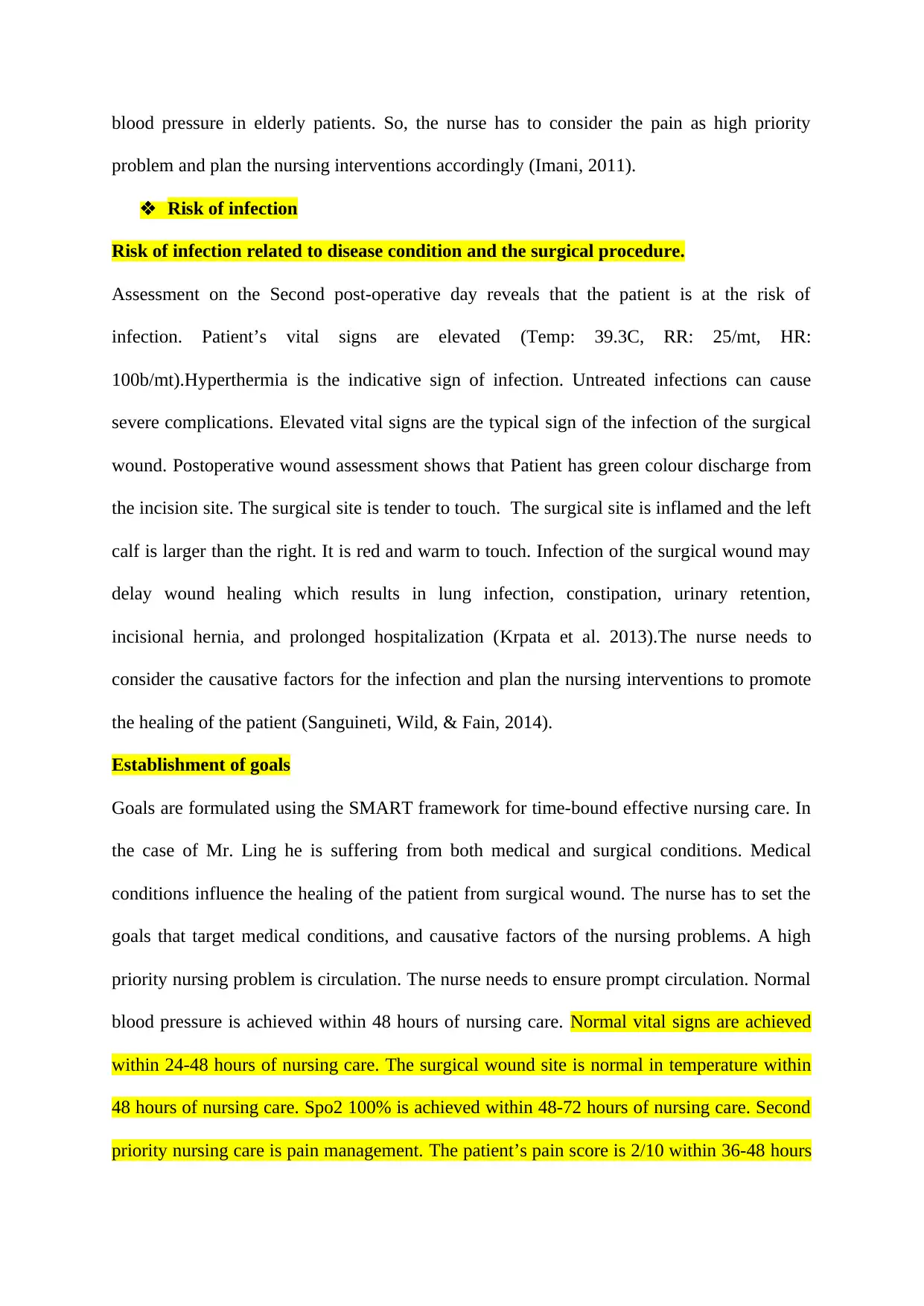
blood pressure in elderly patients. So, the nurse has to consider the pain as high priority
problem and plan the nursing interventions accordingly (Imani, 2011).
Risk of infection
Risk of infection related to disease condition and the surgical procedure.
Assessment on the Second post-operative day reveals that the patient is at the risk of
infection. Patient’s vital signs are elevated (Temp: 39.3C, RR: 25/mt, HR:
100b/mt).Hyperthermia is the indicative sign of infection. Untreated infections can cause
severe complications. Elevated vital signs are the typical sign of the infection of the surgical
wound. Postoperative wound assessment shows that Patient has green colour discharge from
the incision site. The surgical site is tender to touch. The surgical site is inflamed and the left
calf is larger than the right. It is red and warm to touch. Infection of the surgical wound may
delay wound healing which results in lung infection, constipation, urinary retention,
incisional hernia, and prolonged hospitalization (Krpata et al. 2013).The nurse needs to
consider the causative factors for the infection and plan the nursing interventions to promote
the healing of the patient (Sanguineti, Wild, & Fain, 2014).
Establishment of goals
Goals are formulated using the SMART framework for time-bound effective nursing care. In
the case of Mr. Ling he is suffering from both medical and surgical conditions. Medical
conditions influence the healing of the patient from surgical wound. The nurse has to set the
goals that target medical conditions, and causative factors of the nursing problems. A high
priority nursing problem is circulation. The nurse needs to ensure prompt circulation. Normal
blood pressure is achieved within 48 hours of nursing care. Normal vital signs are achieved
within 24-48 hours of nursing care. The surgical wound site is normal in temperature within
48 hours of nursing care. Spo2 100% is achieved within 48-72 hours of nursing care. Second
priority nursing care is pain management. The patient’s pain score is 2/10 within 36-48 hours
problem and plan the nursing interventions accordingly (Imani, 2011).
Risk of infection
Risk of infection related to disease condition and the surgical procedure.
Assessment on the Second post-operative day reveals that the patient is at the risk of
infection. Patient’s vital signs are elevated (Temp: 39.3C, RR: 25/mt, HR:
100b/mt).Hyperthermia is the indicative sign of infection. Untreated infections can cause
severe complications. Elevated vital signs are the typical sign of the infection of the surgical
wound. Postoperative wound assessment shows that Patient has green colour discharge from
the incision site. The surgical site is tender to touch. The surgical site is inflamed and the left
calf is larger than the right. It is red and warm to touch. Infection of the surgical wound may
delay wound healing which results in lung infection, constipation, urinary retention,
incisional hernia, and prolonged hospitalization (Krpata et al. 2013).The nurse needs to
consider the causative factors for the infection and plan the nursing interventions to promote
the healing of the patient (Sanguineti, Wild, & Fain, 2014).
Establishment of goals
Goals are formulated using the SMART framework for time-bound effective nursing care. In
the case of Mr. Ling he is suffering from both medical and surgical conditions. Medical
conditions influence the healing of the patient from surgical wound. The nurse has to set the
goals that target medical conditions, and causative factors of the nursing problems. A high
priority nursing problem is circulation. The nurse needs to ensure prompt circulation. Normal
blood pressure is achieved within 48 hours of nursing care. Normal vital signs are achieved
within 24-48 hours of nursing care. The surgical wound site is normal in temperature within
48 hours of nursing care. Spo2 100% is achieved within 48-72 hours of nursing care. Second
priority nursing care is pain management. The patient’s pain score is 2/10 within 36-48 hours
Paraphrase This Document
Need a fresh take? Get an instant paraphrase of this document with our AI Paraphraser
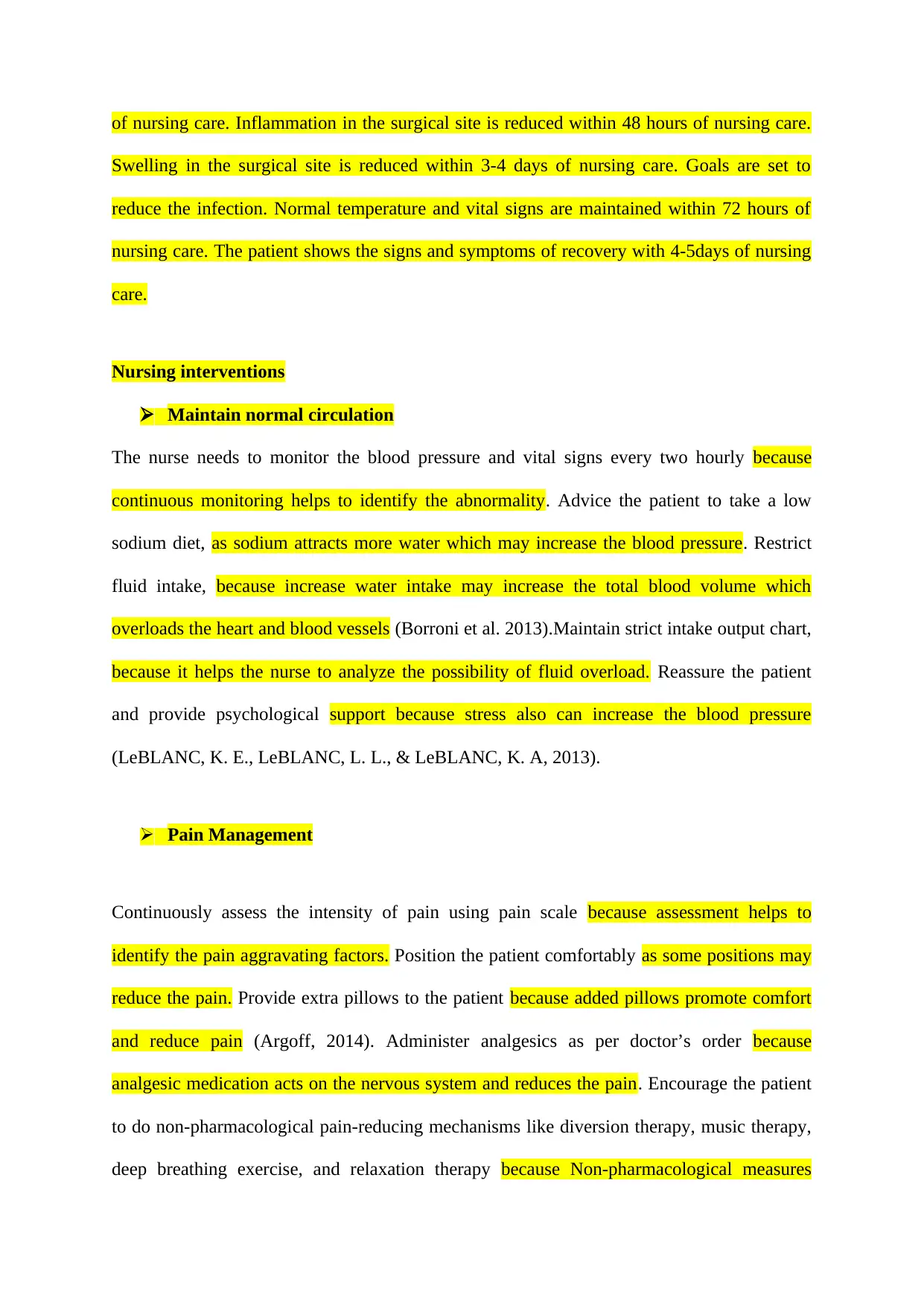
of nursing care. Inflammation in the surgical site is reduced within 48 hours of nursing care.
Swelling in the surgical site is reduced within 3-4 days of nursing care. Goals are set to
reduce the infection. Normal temperature and vital signs are maintained within 72 hours of
nursing care. The patient shows the signs and symptoms of recovery with 4-5days of nursing
care.
Nursing interventions
Maintain normal circulation
The nurse needs to monitor the blood pressure and vital signs every two hourly because
continuous monitoring helps to identify the abnormality. Advice the patient to take a low
sodium diet, as sodium attracts more water which may increase the blood pressure. Restrict
fluid intake, because increase water intake may increase the total blood volume which
overloads the heart and blood vessels (Borroni et al. 2013).Maintain strict intake output chart,
because it helps the nurse to analyze the possibility of fluid overload. Reassure the patient
and provide psychological support because stress also can increase the blood pressure
(LeBLANC, K. E., LeBLANC, L. L., & LeBLANC, K. A, 2013).
Pain Management
Continuously assess the intensity of pain using pain scale because assessment helps to
identify the pain aggravating factors. Position the patient comfortably as some positions may
reduce the pain. Provide extra pillows to the patient because added pillows promote comfort
and reduce pain (Argoff, 2014). Administer analgesics as per doctor’s order because
analgesic medication acts on the nervous system and reduces the pain. Encourage the patient
to do non-pharmacological pain-reducing mechanisms like diversion therapy, music therapy,
deep breathing exercise, and relaxation therapy because Non-pharmacological measures
Swelling in the surgical site is reduced within 3-4 days of nursing care. Goals are set to
reduce the infection. Normal temperature and vital signs are maintained within 72 hours of
nursing care. The patient shows the signs and symptoms of recovery with 4-5days of nursing
care.
Nursing interventions
Maintain normal circulation
The nurse needs to monitor the blood pressure and vital signs every two hourly because
continuous monitoring helps to identify the abnormality. Advice the patient to take a low
sodium diet, as sodium attracts more water which may increase the blood pressure. Restrict
fluid intake, because increase water intake may increase the total blood volume which
overloads the heart and blood vessels (Borroni et al. 2013).Maintain strict intake output chart,
because it helps the nurse to analyze the possibility of fluid overload. Reassure the patient
and provide psychological support because stress also can increase the blood pressure
(LeBLANC, K. E., LeBLANC, L. L., & LeBLANC, K. A, 2013).
Pain Management
Continuously assess the intensity of pain using pain scale because assessment helps to
identify the pain aggravating factors. Position the patient comfortably as some positions may
reduce the pain. Provide extra pillows to the patient because added pillows promote comfort
and reduce pain (Argoff, 2014). Administer analgesics as per doctor’s order because
analgesic medication acts on the nervous system and reduces the pain. Encourage the patient
to do non-pharmacological pain-reducing mechanisms like diversion therapy, music therapy,
deep breathing exercise, and relaxation therapy because Non-pharmacological measures
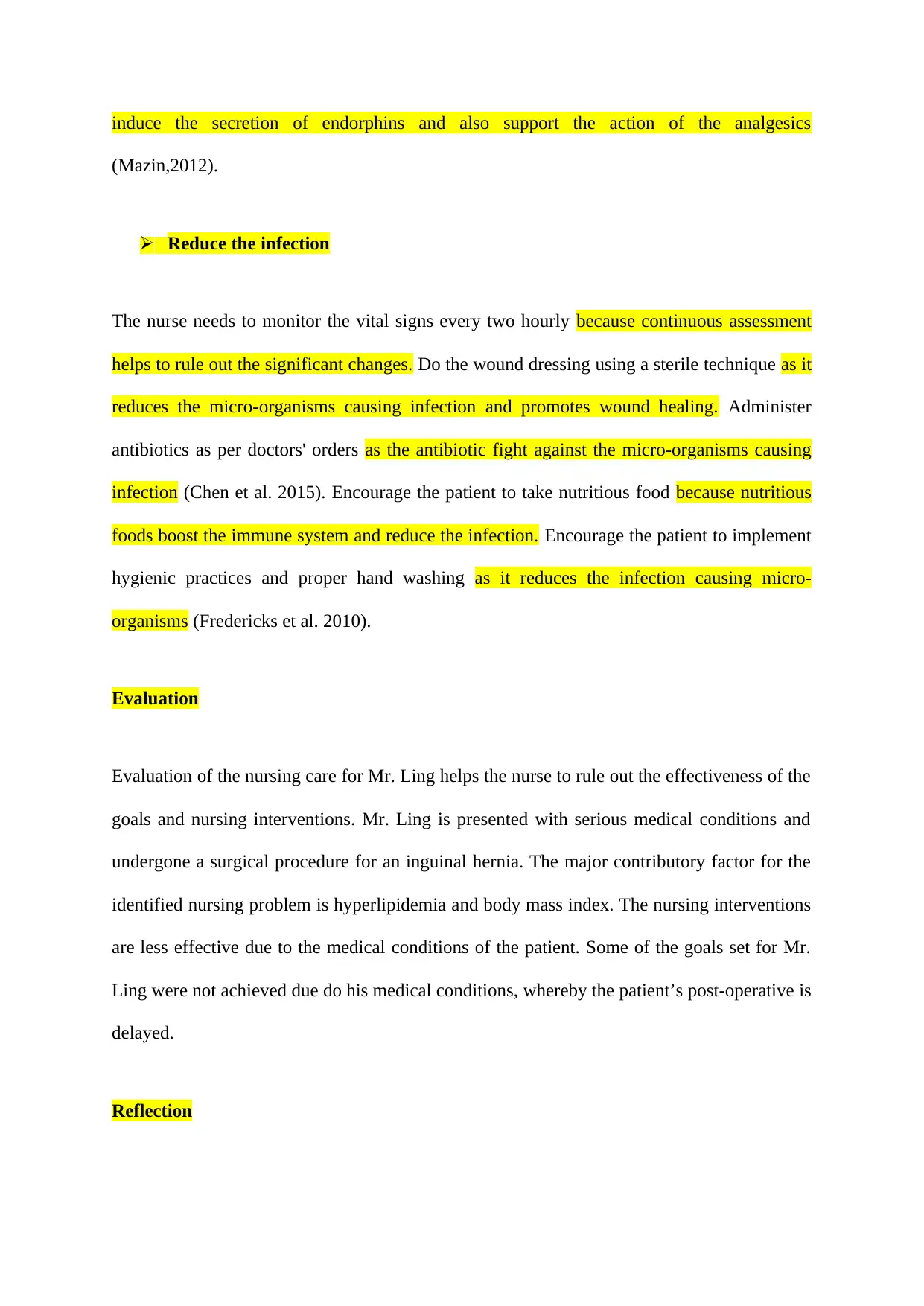
induce the secretion of endorphins and also support the action of the analgesics
(Mazin,2012).
Reduce the infection
The nurse needs to monitor the vital signs every two hourly because continuous assessment
helps to rule out the significant changes. Do the wound dressing using a sterile technique as it
reduces the micro-organisms causing infection and promotes wound healing. Administer
antibiotics as per doctors' orders as the antibiotic fight against the micro-organisms causing
infection (Chen et al. 2015). Encourage the patient to take nutritious food because nutritious
foods boost the immune system and reduce the infection. Encourage the patient to implement
hygienic practices and proper hand washing as it reduces the infection causing micro-
organisms (Fredericks et al. 2010).
Evaluation
Evaluation of the nursing care for Mr. Ling helps the nurse to rule out the effectiveness of the
goals and nursing interventions. Mr. Ling is presented with serious medical conditions and
undergone a surgical procedure for an inguinal hernia. The major contributory factor for the
identified nursing problem is hyperlipidemia and body mass index. The nursing interventions
are less effective due to the medical conditions of the patient. Some of the goals set for Mr.
Ling were not achieved due do his medical conditions, whereby the patient’s post-operative is
delayed.
Reflection
(Mazin,2012).
Reduce the infection
The nurse needs to monitor the vital signs every two hourly because continuous assessment
helps to rule out the significant changes. Do the wound dressing using a sterile technique as it
reduces the micro-organisms causing infection and promotes wound healing. Administer
antibiotics as per doctors' orders as the antibiotic fight against the micro-organisms causing
infection (Chen et al. 2015). Encourage the patient to take nutritious food because nutritious
foods boost the immune system and reduce the infection. Encourage the patient to implement
hygienic practices and proper hand washing as it reduces the infection causing micro-
organisms (Fredericks et al. 2010).
Evaluation
Evaluation of the nursing care for Mr. Ling helps the nurse to rule out the effectiveness of the
goals and nursing interventions. Mr. Ling is presented with serious medical conditions and
undergone a surgical procedure for an inguinal hernia. The major contributory factor for the
identified nursing problem is hyperlipidemia and body mass index. The nursing interventions
are less effective due to the medical conditions of the patient. Some of the goals set for Mr.
Ling were not achieved due do his medical conditions, whereby the patient’s post-operative is
delayed.
Reflection
⊘ This is a preview!⊘
Do you want full access?
Subscribe today to unlock all pages.

Trusted by 1+ million students worldwide
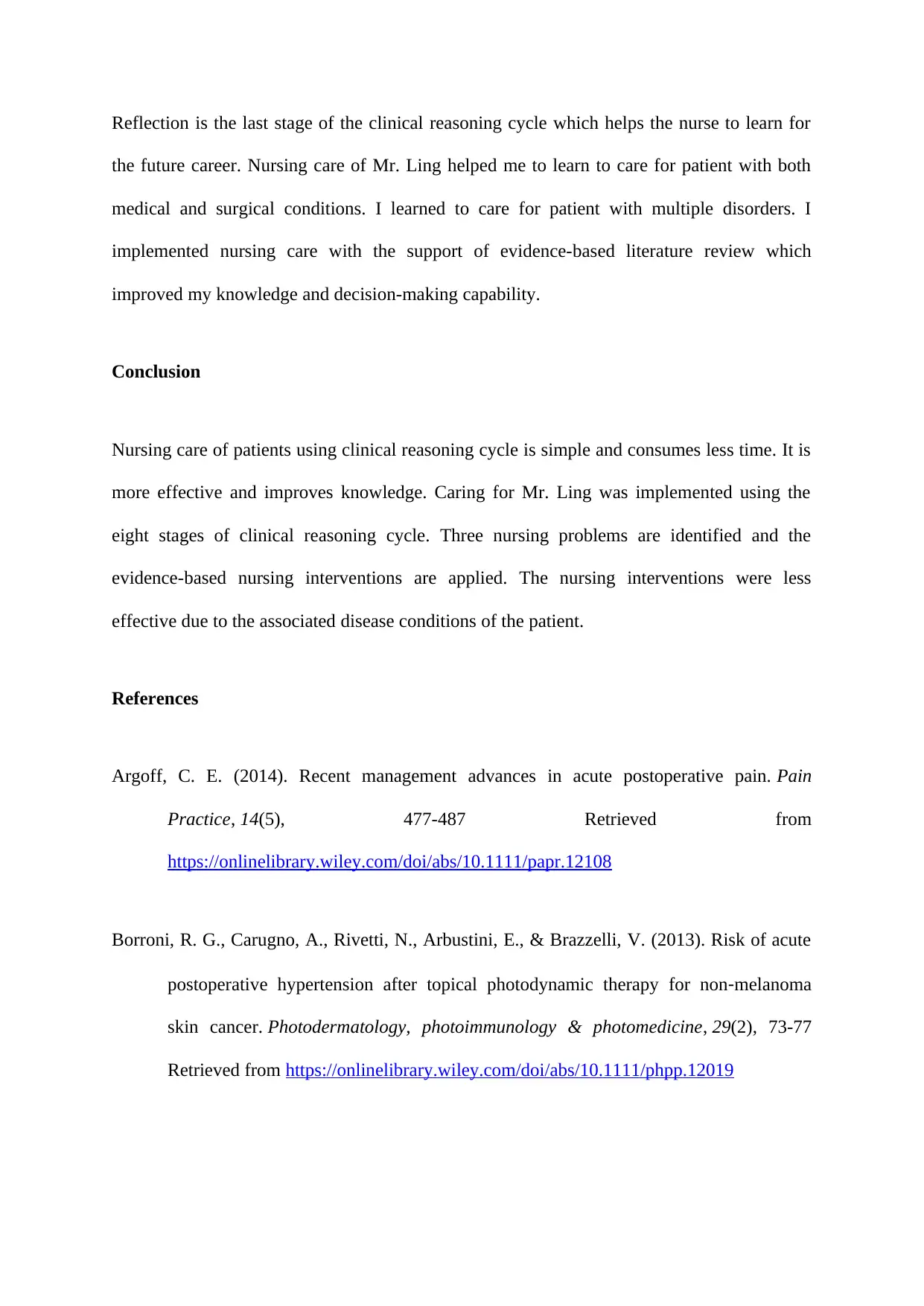
Reflection is the last stage of the clinical reasoning cycle which helps the nurse to learn for
the future career. Nursing care of Mr. Ling helped me to learn to care for patient with both
medical and surgical conditions. I learned to care for patient with multiple disorders. I
implemented nursing care with the support of evidence-based literature review which
improved my knowledge and decision-making capability.
Conclusion
Nursing care of patients using clinical reasoning cycle is simple and consumes less time. It is
more effective and improves knowledge. Caring for Mr. Ling was implemented using the
eight stages of clinical reasoning cycle. Three nursing problems are identified and the
evidence-based nursing interventions are applied. The nursing interventions were less
effective due to the associated disease conditions of the patient.
References
Argoff, C. E. (2014). Recent management advances in acute postoperative pain. Pain
Practice, 14(5), 477-487 Retrieved from
https://onlinelibrary.wiley.com/doi/abs/10.1111/papr.12108
Borroni, R. G., Carugno, A., Rivetti, N., Arbustini, E., & Brazzelli, V. (2013). Risk of acute
postoperative hypertension after topical photodynamic therapy for non‐melanoma
skin cancer. Photodermatology, photoimmunology & photomedicine, 29(2), 73-77
Retrieved from https://onlinelibrary.wiley.com/doi/abs/10.1111/phpp.12019
the future career. Nursing care of Mr. Ling helped me to learn to care for patient with both
medical and surgical conditions. I learned to care for patient with multiple disorders. I
implemented nursing care with the support of evidence-based literature review which
improved my knowledge and decision-making capability.
Conclusion
Nursing care of patients using clinical reasoning cycle is simple and consumes less time. It is
more effective and improves knowledge. Caring for Mr. Ling was implemented using the
eight stages of clinical reasoning cycle. Three nursing problems are identified and the
evidence-based nursing interventions are applied. The nursing interventions were less
effective due to the associated disease conditions of the patient.
References
Argoff, C. E. (2014). Recent management advances in acute postoperative pain. Pain
Practice, 14(5), 477-487 Retrieved from
https://onlinelibrary.wiley.com/doi/abs/10.1111/papr.12108
Borroni, R. G., Carugno, A., Rivetti, N., Arbustini, E., & Brazzelli, V. (2013). Risk of acute
postoperative hypertension after topical photodynamic therapy for non‐melanoma
skin cancer. Photodermatology, photoimmunology & photomedicine, 29(2), 73-77
Retrieved from https://onlinelibrary.wiley.com/doi/abs/10.1111/phpp.12019
Paraphrase This Document
Need a fresh take? Get an instant paraphrase of this document with our AI Paraphraser

Chen, S. H., Lee, C. H., Huang, K. C., Hsieh, P. H., & Tsai, S. Y. (2015). Postoperative
wound infection after posterior spinal instrumentation: analysis of long-term
treatment outcomes. European Spine Journal, 24(3), 561-570 Retrieved from
https://link.springer.com/article/10.1007/s00586-014-3636-9
Fredericks, S., Guruge, S., Sidani, S., & Wan, T. (2010). Postoperative patient education: a
systematic review. Clinical Nursing Research, 19(2), 144-164 Retrieved from
https://journals.sagepub.com/doi/abs/10.1177/1054773810365994
Ghoneim, M. M., & O’Hara, M. W. (2016). Depression and postoperative complications: an
overview. BMC surgery, 16(1), 5. Retrieved from
https://link.springer.com/article/10.1186/s12893-016-0120-y
Imani, F. (2011). Postoperative pain management. Anesthesiology and pain medicine, 1(1), 6.
Retrieved from https://www.ncbi.nlm.nih.gov/pmc/articles/PMC4335751/
Johari, H. G., Paydar, S., Davani, S. Z. N., Eskandari, S., & Johari, M. G. (2009). Left-sided
Amyand hernia. Annals of Saudi Medicine, 29(4), 321-322 Retrieved from
https://www.annsaudimed.net/doi/full/10.4103/0256-4947.55305
Karthikesalingam, A., Markar, S. R., Holt, P. J. E., & Praseedom, R. K. (2010). Meta‐
analysis of randomized controlled trials comparing laparoscopic with open mesh
repair of recurrent inguinal hernia. British Journal of Surgery, 97(1), 4-11 Retrieved
from https://bjssjournals.onlinelibrary.wiley.com/doi/abs/10.1002/bjs.6902
wound infection after posterior spinal instrumentation: analysis of long-term
treatment outcomes. European Spine Journal, 24(3), 561-570 Retrieved from
https://link.springer.com/article/10.1007/s00586-014-3636-9
Fredericks, S., Guruge, S., Sidani, S., & Wan, T. (2010). Postoperative patient education: a
systematic review. Clinical Nursing Research, 19(2), 144-164 Retrieved from
https://journals.sagepub.com/doi/abs/10.1177/1054773810365994
Ghoneim, M. M., & O’Hara, M. W. (2016). Depression and postoperative complications: an
overview. BMC surgery, 16(1), 5. Retrieved from
https://link.springer.com/article/10.1186/s12893-016-0120-y
Imani, F. (2011). Postoperative pain management. Anesthesiology and pain medicine, 1(1), 6.
Retrieved from https://www.ncbi.nlm.nih.gov/pmc/articles/PMC4335751/
Johari, H. G., Paydar, S., Davani, S. Z. N., Eskandari, S., & Johari, M. G. (2009). Left-sided
Amyand hernia. Annals of Saudi Medicine, 29(4), 321-322 Retrieved from
https://www.annsaudimed.net/doi/full/10.4103/0256-4947.55305
Karthikesalingam, A., Markar, S. R., Holt, P. J. E., & Praseedom, R. K. (2010). Meta‐
analysis of randomized controlled trials comparing laparoscopic with open mesh
repair of recurrent inguinal hernia. British Journal of Surgery, 97(1), 4-11 Retrieved
from https://bjssjournals.onlinelibrary.wiley.com/doi/abs/10.1002/bjs.6902

Krpata, D. M., Blatnik, J. A., Novitsky, Y. W., & Rosen, M. J. (2013). Evaluation of high-
risk, comorbid patients undergoing open ventral hernia repair with synthetic
mesh. Surgery, 153(1), 120-125 Retrieved from
https://www.sciencedirect.com/science/article/abs/pii/S0039606012002905
LeBLANC, K. E., LeBLANC, L. L., & LeBLANC, K. A. (2013). Inguinal hernias: diagnosis
and management. Am Fam Physician, 87(12), 844-848 Retrieved from
https://pdfs.semanticscholar.org/37ed/f64a6b3458ac1f6f6f455b0fb415b49f2767.pdf
Mavros, M. N., Athanasiou, S., Alexiou, V. G., Mitsikostas, P. K., Peppas, G., & Falagas, M.
E. (2011). Risk factors for mesh-related infections after hernia repair surgery: a meta-
analysis of cohort studies. World journal of surgery, 35(11), 2389 Retrieved from
https://link.springer.com/article/10.1007/s00268-011-1266-5
Mazin, J. B. (2012). Causes of postoperative pain following inguinal hernia repair: what the
literature shows. Prat Pain Manag Retrieved from
https://www.practicalpainmanagement.com/causes-postoperative-pain-following-
inguinal-hernia-repair-what-literature-shows?page=0,2
Papadopoulos, D. P., Mourouzis, I., Thomopoulos, C., Makris, T., & Papademetriou, V.
(2010). Hypertension crisis. Blood pressure, 19(6), 328-336 Retrieved from
https://www.tandfonline.com/doi/abs/10.3109/08037051.2010.488052
Sanguineti, V. A., Wild, J. R., & Fain, M. J. (2014). Management of postoperative
complications: general approach. Clinics in geriatric medicine, 30(2), 261-270
risk, comorbid patients undergoing open ventral hernia repair with synthetic
mesh. Surgery, 153(1), 120-125 Retrieved from
https://www.sciencedirect.com/science/article/abs/pii/S0039606012002905
LeBLANC, K. E., LeBLANC, L. L., & LeBLANC, K. A. (2013). Inguinal hernias: diagnosis
and management. Am Fam Physician, 87(12), 844-848 Retrieved from
https://pdfs.semanticscholar.org/37ed/f64a6b3458ac1f6f6f455b0fb415b49f2767.pdf
Mavros, M. N., Athanasiou, S., Alexiou, V. G., Mitsikostas, P. K., Peppas, G., & Falagas, M.
E. (2011). Risk factors for mesh-related infections after hernia repair surgery: a meta-
analysis of cohort studies. World journal of surgery, 35(11), 2389 Retrieved from
https://link.springer.com/article/10.1007/s00268-011-1266-5
Mazin, J. B. (2012). Causes of postoperative pain following inguinal hernia repair: what the
literature shows. Prat Pain Manag Retrieved from
https://www.practicalpainmanagement.com/causes-postoperative-pain-following-
inguinal-hernia-repair-what-literature-shows?page=0,2
Papadopoulos, D. P., Mourouzis, I., Thomopoulos, C., Makris, T., & Papademetriou, V.
(2010). Hypertension crisis. Blood pressure, 19(6), 328-336 Retrieved from
https://www.tandfonline.com/doi/abs/10.3109/08037051.2010.488052
Sanguineti, V. A., Wild, J. R., & Fain, M. J. (2014). Management of postoperative
complications: general approach. Clinics in geriatric medicine, 30(2), 261-270
⊘ This is a preview!⊘
Do you want full access?
Subscribe today to unlock all pages.

Trusted by 1+ million students worldwide

Retrieved from https://www.geriatric.theclinics.com/article/S0749-0690(14)00006-8/
abstract
abstract
1 out of 10
Related Documents
Your All-in-One AI-Powered Toolkit for Academic Success.
+13062052269
info@desklib.com
Available 24*7 on WhatsApp / Email
![[object Object]](/_next/static/media/star-bottom.7253800d.svg)
Unlock your academic potential
Copyright © 2020–2025 A2Z Services. All Rights Reserved. Developed and managed by ZUCOL.





